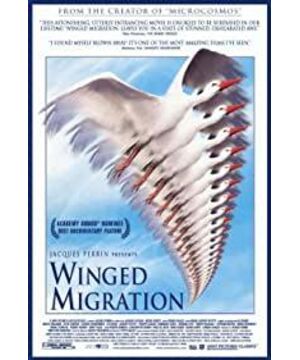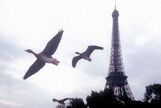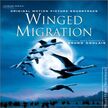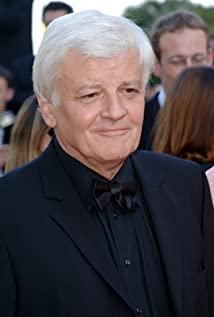At the beginning of the film, the female bird is looking for food to feed the bird. Is it because the monks can’t afford too much porridge and can only watch their children die like this, or is it because of the survival of the fittest that they naturally face the children who are thrown out? No way to know.
The little boy untied the ropes that tied the grey geese, and the lone bird spread its wings to follow the flock ahead. The narrator reads: "The migration of birds is a story about a promise, a promise to return. Their journeys are long distances, they have gone through many crises, and they have only one purpose: to survive.
Then it is to survive, and in order to survive, they are just born . Birds can also push their own brothers away; in order to survive, they leave their companions to fly to a distant place, and they can only chase after being abandoned; in order to survive, they migrate twice a year, fly, and use the sun, moon and stars to identify the direction, which is also very important to climate change. Sensitive; they are just to fulfill a promise to fly from the northern hemisphere to the North Pole, then from the North Pole to the South Pole.
"There is nothing to stop them, straight to the distance". They fly over the mountains and over the sea, stay and find a place to rest , or continue to move forward without rest. The snow-capped mountains are mixed with wind and snow, and the heavy snow gradually covers the webbed wings and necks. When the sun shines again, they chirp and get up. After a while, the avalanche comes; Captive, apart from the life of flying, but also lost the most important freedom: flying to the other side, falling from the blue sky with the sound of gunshots, the silhouettes of human beings are looming; the dirty rivers in the city, the gray sky, the heavy industry destroys the city It was a mess, trapped, and eventually the birds left; the nests of the chicks on the wasteland were not found but great danger was coming; 600 kilometers, 1200 kilometers, 1800 kilometers, 2500 kilometers, 10000 kilometers, all numbers firmly proved them Flying to the distance to find the direction of survival, and how hard and difficult this journey is is indescribable.
The hard work of a long-distance flight, the challenges of nature, and the approaching of human beings, the birds have only one purpose, which is to survive. But the price of this survival is to overcome one bumpy road, find the right direction, and protect yourself from being killed. They are in the mountains, in the sea, in the snow-capped mountains, in the city, in the wilderness, in the sky, with their wings spreading and swinging, flying forward without stopping. This is their destiny, but it is also their shining point.
The filming of "Migrating Birds" lasted 4 years and spanned five continents. The film used was 460 kilometers long. Pilots and scientific expeditions were used. About 400 people participated in the shooting every day. These are all in order to obtain reality. Director Jacques Behan has made more than 100 films, and "Migrating Birds", "Microcosm" and "Himalaya" are called the natural epic masterpiece "Heaven, Earth and Man" trilogy. His films Got the best moment.
Jacques Behan said living with birds for four years, training the flock, that is, being able to move with the movements of the birds, familiarizing the flock with their presence and following, and getting as close to them as possible. This has also contributed to the natural and beautiful pictures we see, and time is the best and most basic guarantee. And Jacques Behan also has a very strong artistic sense for the selection and shooting of lenses, and every picture in the film can be frozen into an excellent photographic work. You walk with the camera, or shoot overhead, shoot up, or parallel, and follow the birds to fly up and enjoy the picturesque scenery below. The creation of music also complements the flock of birds, lively playing with the flock of birds, the bright and distant Ming brother, the tense orchestral ensemble, the singing of the gospel, and the sea, desert, forest, river, glaciers and valleys are silently dependent on each other.
I have always felt that in shooting, the natural landscape is simple and the characters are simple. It is more difficult than this to be babies and animals. They cannot control and cannot control, they can only follow their pace, but this can reflect the reality more, which may be why Why Jacques Behan chose the flock for his documentary. They can only try to get close to the flock to capture the natural gestures, rather than ordering the flock to do. And this kind of shooting is also very difficult, the energy, human, financial and material resources spent are extremely huge, and the truth obtained is also the most touching. Similarly, the use of birds as the main body in the camera makes people feel that the audience is flying with the birds. This kind of scientific and educational nature is deeply hidden, and it can move the audience to identify with their own bird identity.
The purpose of flock flight is just to survive, and a lot of sacrifices are also made in this purpose of survival. They can't take every companion, and they choose to look forward and not look back. And they migrate twice a year, moving forward without stopping, flying without giving up, and the sky is their home. The wind gently caresses the wings, the sea gently sings the song of farewell, even if the thorns are full, it cannot stop. The old woman waiting for the migratory birds to return to feed is also a tender shot.
The documentary "Migrating Birds" has huge surprises in both shooting skills and content form. The visual impact is strong, real and natural. Regardless of the many awards it has won, the migration of birds is like a baptism of life. , like taking us through a life migration.
It's homework, it's confusing and confusing.
View more about Winged Migration reviews









